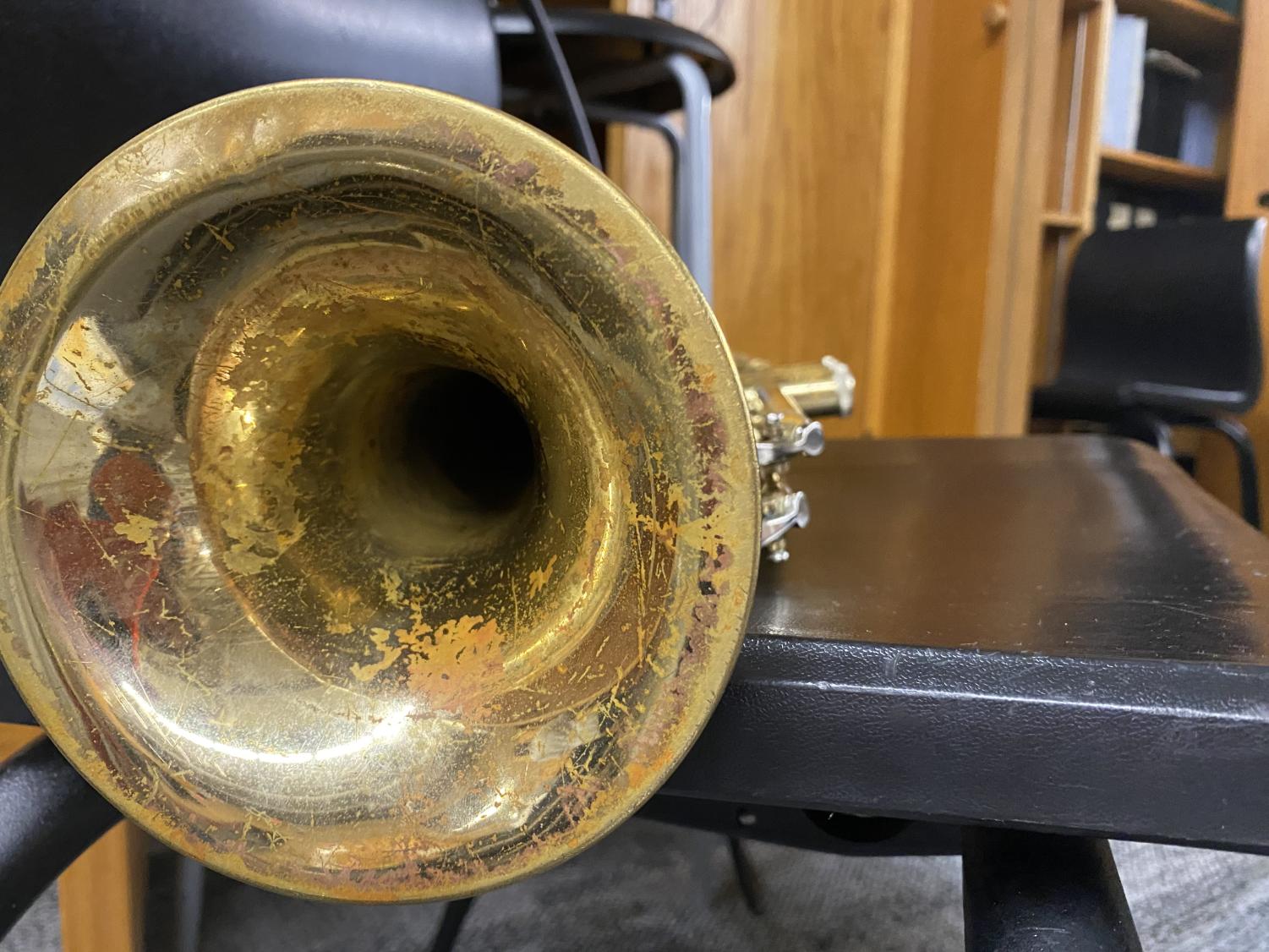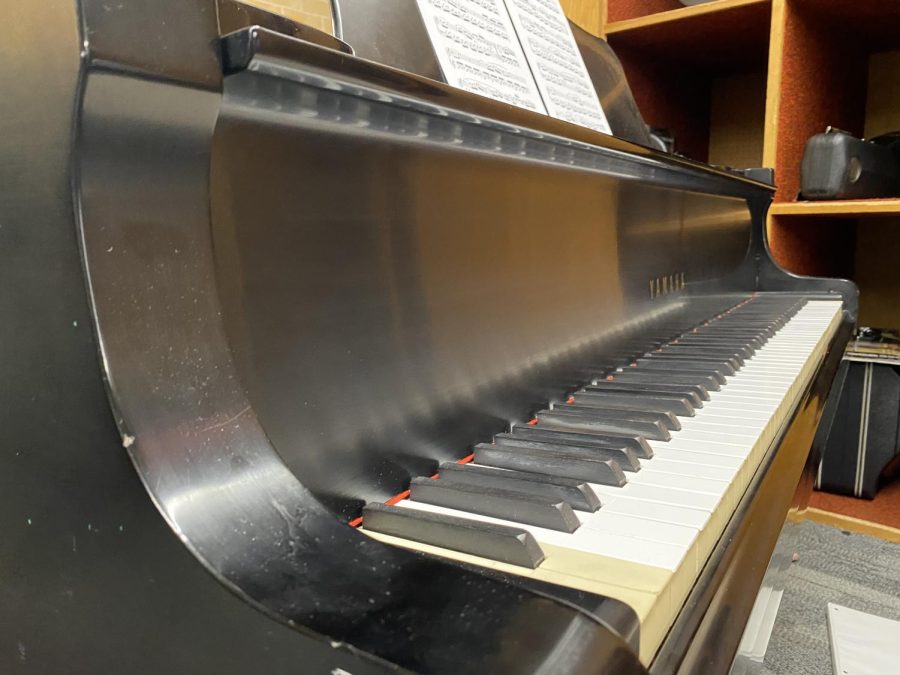The Decline
Thirty years ago, one hundred BSM students auditioned for roles in musicals and full risers of choir students sang at mass. But the cast list of White Christmas, BSM’s most recent production, included just 27 students. In the past two decades, many of BSM’s arts programs–band, choir, theater –have experienced a significant decline in participation.
This decline is not the result of a single factor. Instead, a “perfect storm” of schedule changes, program competitors, administration’s decisions, and pandemic precautions limited students’ exposure to the arts. “It is not one thing, one teacher; it has been a constant almost hurricane over us since about 2006,” former Choir Director Nancy Stockhaus said.
Beginning in the early 2000s, high schools specifically focused on the arts opened in the Minneapolis area. Schools like PIM (Performance Institute of Minnesota) and the Saint Paul Conservatory for Performing Artists make the arts a central part of curriculum and cater to students looking to pursue them professionally. Bigger public schools, like Wayzata or Minnetonka, have top-ranked arts programs that draw hundreds of students. As these programs develop, prospective BSM students who are serious about the arts often opt for those schools.
“We noticed a big change in how many kids who were coming to Benilde who were interested in the arts because they had other options…we also had a lot of competition at that time from Minnetonka, Wayzata; they have superb theater programs because they’re huge schools. They drew from huge amounts of kids and we draw from maybe 1200 kids,” Stockhaus said.
Even the students BSM does draw from usually favor sports over the arts. “I would say the large portion of our kids are involved in sports, especially now…I’ve noticed a big difference,” Stockhaus said.
While simultaneously competing with these top schools, BSM’s arts program fell victim to a series of schedule changes. In the past decade, BSM has changed their schedule requirements almost every year. One of the more recent changes was the elimination of wellness during BSM hour. Students who couldn’t fit an elective in their schedule used their wellness to take choir.
“For a musician that is terrible …It would be like telling the football or hockey team that your schedule has been shortened to 6 weeks. You will still get the same amount of time on the field/ice but now 4/5 hour practices a day and 2 or 4 games a week. Then you are off for 9 months and are expected to be better when you show up next year with no further involvement/encouragement or guidance. There is no logic to this scenario,” former Band Director Paul Keefe said in an email interview.
BSM alum (‘18) and recent Harvard grad Eric Wilson was a student who took advantage of the wellness hour to take arts classes. “I was in band and choir. I was in band as my “normal arts” and I would schedule my free hour for when the choir was practicing,” Wilson said.
Even before the wellness requirement shifted, the BSM administration often encouraged students to pursue other electives. Engineering and biomed, two of BSM’s most popular electives, are often highlighted on social media and in tours for prospective students. This can be attributed to America’s greater focus on STEM in education. Beginning in the early 2010s, politicians, educators, and even corporations encouraged American schools to focus on STEM to push innovation and create a talented workforce. This focus on STEM can come at the expense of a well-rounded education, especially the arts.
“The emphasis was on science and everything associated with STEM. We pleaded with them to make it STEAM or STREAM, we could have done that. But STEM was the big thing. That put a crushing blow for us as well,” Stockhaus said.
As BSM pushed harder for STEM, some students stopped taking choir because they felt the program didn’t get enough recognition.
“We only have two concerts throughout the year where we showcase everything we’ve learned. A lot of time feels wasted on rehearsing the same couple of songs over and over when we could be doing work,” senior and former choir member Greta Hall said.
STEM became an educational buzzword around the same time that selectivity in college admissions skyrocketed. There is a common misconception that colleges prefer electives like engineering to arts classes like choir or band. Students aiming to attend a top college may opt for STEM electives instead of taking the arts. In reality, many colleges favor arts electives.
“Students believe erroneously that it’s all about academics. The richer candidate is not just academic…One extra AP class is not going to make the students stronger,” Carnegie Mellon University Dean of Admissions Mike Steidel said in the program of a public school’s band concert.
As the above factors continued to hurt numbers, the pandemic delivered a crushing blow. The CDC’s social distancing and masking requirements made singing virtually impossible. Students playing outdoor sports could continue their seasons as normal, but the BSM choir and band programs had to get creative. Despite their creativity, it was difficult for the arts to recruit new students when they couldn’t actually sing.
“The pandemic was a horrible time for the arts. We couldn’t be onstage, whereas kids in sports could be outside. We were tied to doing things on Zoom, and we know how terrible that is. Especially for singing,” Stockhaus said.
Most recently, BSM cut the full-year arts requirements in the Junior High. Not only does this limit the numbers in the Junior High choir and band, it also limits exposure to programs students might be interested in in high school.
“With everything else, that really slammed the band and choir. We didn’t have the opportunity to reach out to these kids and have them see the benefits of having a band or choir for a full year,” Stockhaus said.
Like any athlete, musicians need to practice to perfect their craft. Limiting the Junior High requirement to only a half year prevents these students from reaching their full potential.
“If you’re going to do especially band and play an instrument, you need to do it for a full year. Otherwise you lose so much of your technique… it’s the same for singing. It’s a muscle. If you really want to be a singer, you don’t just do it for half a year,” Stockhaus said.
The Significance
Participating in the arts benefits students in all areas of academic and personal life. English teacher Jennifer Bevington has been involved in the arts her whole life, participating in the theater in high school and continuing with orchestra and choir in college and beyond. “Involvement in the arts for me has had a lot of different benefits in my life. One of the really big pieces…has been about identity and finding a sense of self and sense of confidence in the arts,” Bevington said.
In addition to a sense of self, the arts give students a sense of community. “People have to have community and participation in the arts offers such a beautiful sense of community,” Bevington said.
Within the school community, participating in the arts in addition to other classes and athletics allows students to meet new people. “Generally, it’s always better to broaden yourself. As you broaden yourself, you get a feel for different types of people…it’s so beneficial for later on it life,” Wilson said.
When students collaborate on art projects, they learn to work together. “[The arts] involve creating/exploring/understanding/developing skills not alone, but collaborating with a group to produce a worthwhile outcome. This involves all the different learning styles that are out there.. Qualities that any employer would be dreaming of for a future employee,” Keefe said.
In fact, Wilson believes the arts taught him more about teamwork than his college football team. “A lot of people assume that I got my experience…being a team player through sports, but I think the arts helped me even more than playing football. When you’re in music, you’re part of a bigger whole. You aren’t necessarily working towards making yourself the most presentable piece,” Wilson said.
The arts help students perform well academically. Countless studies have connected the arts to improved memory. “When I’m in a nursing home…what am I going to remember? I’m going to remember music. And that’s not because I’m a music teacher. Music gets into that part of your brain,” Stockhaus said.
While most classes at BSM use laptops for the majority of work, arts classes give students a break from their screens. “We made the decision to not use [the laptop] and to make it the place where students didn’t stare at a screen. Now we know from science that staring at screens is not good for you, and we’d rather use that time to practice and learn about music,” Stockhaus said
The Solution
According to Stockhaus and other arts teachers at BSM, administration can reverse this trend by adjusting their focus and schedule to accommodate the arts. To start, they should consider requiring a full year of the arts in Junior High and bringing back wellness.
“I know why they did it after the pandemic, but it was extremely detrimental to the music department. That’s one thing that could be looked at again… making room for the arts in student’s schedules. And making room for the arts in student’s schedules. Taking away wellness completely obliterated the high school choir,” Stockhaus said.
One option could be changing STEM to STEAM. This gives a place for the arts in curriculum and encourages students to pursue them.
“They’ve added so many science classes and engineering classes. I get that [BSM] sees the benefit in those, but I just feel bad that they don’t see the benefit in music,” Stockhaus said.
Promoting the arts will also help students with their academic success. “Fine arts are a key ingredient to innovation. Without creativity and inspiration that comes from the arts, you can never be successful,” Steidel said.
Another potential option is adding new courses that incorporate the arts in different ways. The visual arts program at BSM has remained popular among students. Department head Kelli Rahn attributes these strong numbers to the new courses offered.
“Last year, we were given the opportunity to add some new classes…that gained some attention from students that has helped,” Rahn said.
Outside of the administration, the entire BSM community can cultivate the arts by showcasing and appreciating them. This year, the marketing and communications department is making a more conscious effort to show the arts on social media and with the admissions team.
“We [showcase] visual arts and performing arts. What we’ve been doing with visual arts is showcasing them on social media and… talking with the students to do an interview [about their piece]… With the performing arts… it’s been to identify what they are doing and then how to promote it,” Marketing and Communications Director David Lucs said.
This approach is also tied to admissions at BSM. If the marketing department can showcase the arts well, then prospective arts students might choose to attend. Sharing pieces in local media brings awareness to their art programs. “It also heightens awareness…it helps the admissions process,” Lucs said.



